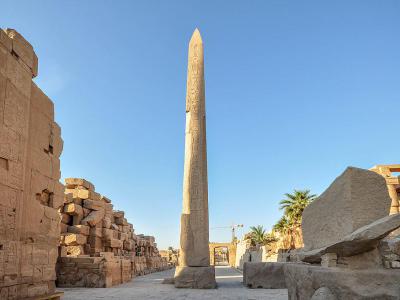
Obelisk of Thutmose I, Luxor
The Obelisk of Thutmose I, situated within the Karnak Temple complex, stands as a testament to ancient Egyptian craftsmanship and grandeur. Erected during the reign of Thutmose I around 1493-1479 B.C.E., this imposing structure once formed part of the entrance to the temple, flanking the Fourth Pylon. Carved from a single shaft of red granite sourced from Aswan, it rises to a height of 71 feet (21.7 meters) atop a base measuring 6 feet (1.8 meters) square, weighing an impressive 143 tons.
Despite the passage of over three millennia, the obelisk remains a striking presence, adorned with inscriptions attributed to Thutmose I himself. Each side of the monument bears three vertical lines of text, the central one serving as a dedication by the ancient ruler. Originally standing alongside its twin, as documented by the traveler Richard Pococke in the late 1730s, only one obelisk remains upright today, leaning slightly but retaining its historical significance.
Throughout its long history, the obelisk has witnessed modifications, reflecting the shifting political and religious landscape of ancient Egypt. Columns were added by Ramesses IV on either side of the central inscriptions, only to be later usurped by Ramesses VI, underscoring the complex interplay of power and tradition in Egyptian society.
Despite the passage of over three millennia, the obelisk remains a striking presence, adorned with inscriptions attributed to Thutmose I himself. Each side of the monument bears three vertical lines of text, the central one serving as a dedication by the ancient ruler. Originally standing alongside its twin, as documented by the traveler Richard Pococke in the late 1730s, only one obelisk remains upright today, leaning slightly but retaining its historical significance.
Throughout its long history, the obelisk has witnessed modifications, reflecting the shifting political and religious landscape of ancient Egypt. Columns were added by Ramesses IV on either side of the central inscriptions, only to be later usurped by Ramesses VI, underscoring the complex interplay of power and tradition in Egyptian society.
Want to visit this sight? Check out these Self-Guided Walking Tours in Luxor. Alternatively, you can download the mobile app "GPSmyCity: Walks in 1K+ Cities" from Apple App Store or Google Play Store. The app turns your mobile device to a personal tour guide and it works offline, so no data plan is needed when traveling abroad.
Obelisk of Thutmose I on Map






Sight Name: Obelisk of Thutmose I
Sight Location: Luxor, Egypt (See walking tours in Luxor)
Sight Type: Attraction/Landmark
Sight Location: Luxor, Egypt (See walking tours in Luxor)
Sight Type: Attraction/Landmark
Walking Tours in Luxor, Egypt
Create Your Own Walk in Luxor
Creating your own self-guided walk in Luxor is easy and fun. Choose the city attractions that you want to see and a walk route map will be created just for you. You can even set your hotel as the start point of the walk.
Luxor East Bank Walking Tour
The East Bank area is located in the heart of Luxor city. It has plenty of top sights including wonderful working temples and museums, such as the Luxor Temple, the Karnak Temple Complex, the Luxor Museum and the Mummification Museum. Take our tour to experience the beauty of Luxor’s East Bank district.
Tour Duration: 2 Hour(s)
Travel Distance: 4.7 Km or 2.9 Miles
Tour Duration: 2 Hour(s)
Travel Distance: 4.7 Km or 2.9 Miles
Luxor Archaeology Tour Part 1
The Theban necropolis area - located in Upper Egypt, across the River Nile from the modern city of Luxor - is considered to be one of the most significant archaeological sites in the world. You will be amazed by the many splendid temples, tombs and other historic attractions in this area, which is now known as Luxor's West Bank. The ruins of the Workers Village, the Colossi of Memnon, and... view more
Tour Duration: 3 Hour(s)
Travel Distance: 6.5 Km or 4 Miles
Tour Duration: 3 Hour(s)
Travel Distance: 6.5 Km or 4 Miles
Luxor Archaeology Tour Part 2
The West Bank area of Luxor - located across the River Nile from the modern city itself - is a true archaeological paradise full of must-see sights for any visitor. There are a number of ancient Egyptian pharaoh tombs, necropolises and temples here, dating from the time of the ancient city of Thebes. Take our walking tour to see all the best sights in the area.
Tour Duration: 2 Hour(s)
Travel Distance: 3.9 Km or 2.4 Miles
Tour Duration: 2 Hour(s)
Travel Distance: 3.9 Km or 2.4 Miles



